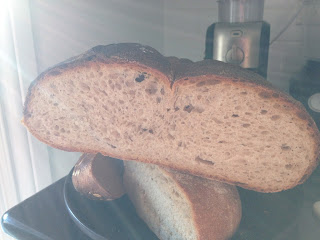Here's a really nice sourdough loaf I made a while ago. It's light, porous, and flavourful- everything you'd want in a country-style bread to serve with cheese or as toast.
It also looks like a butt. Hah.
Look at that open crumb! I've made this bread twice in two weeks, and normally I'm all about trying something new. That's just how good this bread is. It's mostly made with plain wheat flour, along with a little bit of whole wheat and rye to build character. A thin wooden rod cleaves the loaf into two halves, giving it the distinctive shape of a bum (sorry, can't get over that) or maybe a coffee bean (if you're more mature than me).
Okay, I'll stop now.
Pain Fendu
Adapted from Ketex.de
For the Sourdough:
75 g. Whole wheat flour
75 g. Water
7.5 g. Sourdough starter
Mix all and leave at room temperature, covered, for 16 hours.
Final Dough:
500 g. Bread flour
30 g. Dark rye flour
30 g. Whole wheat flour
340 g. Water
Sourdough
12 g. Salt
6 g. Fresh yeast, or 2 g. active dry yeast
In about 2 TBSP of the water, dissolve the yeast.
Mix the remaining water and the flour into a rough dough. Let rest 30 minutes.
Add the yeast, sourdough and salt. Knead until the dough is elastic and smooth, no longer sticking to the sides of the bowl.
Let the dough rise in a covered bowl for 90 minutes, stretching and folding ever 30 minutes.
On a floured surface, shape the dough into an oblong boule. Let rest 15 minutes.
Use a long, thin, clean wooden or metal stick to press down in the middle of the loaf, dividing it into two halves without actually cleaving the dough. Let rest covered, with the stick still inside, for 2 1/2 hours. Preheat the oven to 250℃.
Remove the stick before baking. Bake for about 10 minutes on the lower shelf of the oven, spraying the inside of the oven with a spray bottle full of water to create steam at the very beginning (this gives a crispier crust). Open the door of the oven briefly to release steam. Then, reduce the temperature to 230℃ and bake for another 20-25 minutes, or until the bread is 190℉ inside when tested with a thermometer. Cover with aluminium foil if it browns too rapidly.
Let cool completely before cutting.



No comments:
Post a Comment